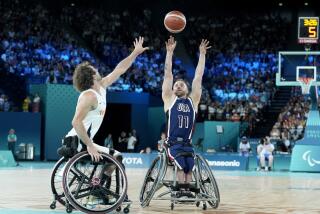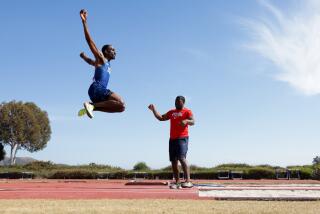Classes Buoy Handicapped : Swimmers Learning Safety, Exercise and Fun
- Share via
Two attendants lift Dee Dee Heath out of her wheelchair and onto the lip of the deck at the Sepulveda Pool. Her legs dangle limply in the water.
“Go for it!” exclaims her husband, George. She leans forward, her weight slowly shifting until she belly-flops into the water. She lies face-down for a second, motionless, then twists her face up for air and propels away from the shallow end, using what she calls “a modified crawl.” Her arms barely leave the water and her kick is stiff and weak, but it works.
Heath, 29, the mother of four, was diagnosed at 11 months old as having cerebral palsy. This summer, she was one of about 4,000 handicapped people who visited 25 Los Angeles city pools that participated in an Adapted Aquatic Swim Program, either for special swim lessons or for recreational swimming. The program continues this fall at eight year-around pools operated by the city and other local facilities.
Compassion, Creativity
Teaching the physically or mentally handicapped to swim takes compassion, creativity and know-how. “It’s not just like (having) a pool full of kids,” said Joe Jondreau, a private adaptive aquatics instructor.
“The ultimate goal is water safety,” said Tracy Davis-West, coordinator of adapted aquatics for the Pacific Region of the Department of Recreation and Parks, “but we also try to get across that the water can be fun.”
Certain basics are covered with all disabled people. Breath control is important, although it is not the first skill taught in some cases. According to Vicki Geyer, who teaches adaptive physical education for the Los Nietos School District in Whittier, some physically handicapped people first are taught to float on their backs as a safety precaution.
Movements that are taken for granted by those without handicaps must be adapted to the particular limitations of the handicapped swimmer. Geyer tells her physical education students to gather background information on each prospective swimmer’s disability or impairment.
Her 24-hour course includes simulations in which the student teachers sample being blind or otherwise physically impaired. She urges her students to put themselves in the place of the handicapped. “They (the teachers) have to accept their swimmers as persons,” she said.
For a handicapped person, simply getting in and out of the pool can be a problem. Like Heath, most wheelchair-bound people use a two-person lift. However, some pools are equipped with ramps and hydraulic lifts.
Davis-West said adaptive aquatics teachers must be creative, assessing each student’s limitations and abilities as well as the swimming environment, to develop a program around them. They often must devise a modified swim stroke for disabled students.
Water Temperature Important
The water must be just right for some swimmers. Water temperatures around 90 degrees are desirable for people with such disorders as muscular dystrophy or cerebral palsy, Geyer said. Heath said she feels uncomfortable if the water temperature is lower than 85 degrees. Also, it is easier to get out of the pool if the water level is high.
Once in the water, success is measured in the trust that teachers build with their students. “If they don’t feel safe, they don’t have fun and don’t learn,” Jondreau said.
With mentally handicapped people, the instructors must simplify processes, provide plenty of repetition and--above all--learn patience. “What it takes a regular swimmer one summer to learn, it takes us three (to teach),” said Geyer, who also works with the trainable mentally retarded.
“I swim like a fish,” said Ed Freeman, 21, who is moderately retarded and has a severe seizure disorder. He said that floating was the most difficult water skill for him to learn. The twice-a-week lessons he takes at Reseda Pool “make me feel good,” he said.
Other categories of the disabled have their own needs. “A blind person requires, initially, one-on-one assistance,” Jondreau said. “They are motored through (the lesson) holding the instructor’s hand.” When a blind person has made a mental map of the pool, the number of steps and so on, he or she can be more independent. “Ideally, you want the person as independent as possible,” Geyer said.
Fear of the water generally is not a problem with disabled swimmers. Peter (the group’s policy is not to make public last names of clients), 11, takes adaptive lessons at the Van Nuys-Sherman Oaks Pool through Project Six, a private group. Peter, who is mentally retarded, said that he was never afraid of the water, only annoyed that it was so cold. He is able to swim the width of the Reseda pool, but doesn’t go into the deep water.
Fear of Water
“Fear of water is, if anything, a little less than (it is with) the general population,” Jondreau said. “Virtually all the disabled people I have worked with have liked the water. It may be partly because their range of activities is so limited, and this is a whole new environment for them.”
Lenny Ott, 28, who has cerebral palsy and takes twice-weekly adaptive lessons at Sepulveda Pool, said that he gets around “a lot better” in the water than he does on land. This new mobility has improved his mental outlook, he said.
“They can move without the force of gravity, Geyer said. “It gives them a new freedom.”
Jondreau said that water puts the handicapped on a closer level with the non-handicapped. “They have a greater range of motion,” he said. “They can do many of the things in the water that the general population can do.” Swimming is also important to the handicapped as a form of exercise. “It hits every part of the body,” Geyer said. And Heath, who has included swimming in her regular therapy program, said she has noticed a marked increase in the ability to use her arms. In fact, she has been reclassified from quadriplegic to paraplegic.
Backstroking to deck side, she revealed an ambition. “I want to teach my children to swim,” she said. “Then we could swim as a family.”


